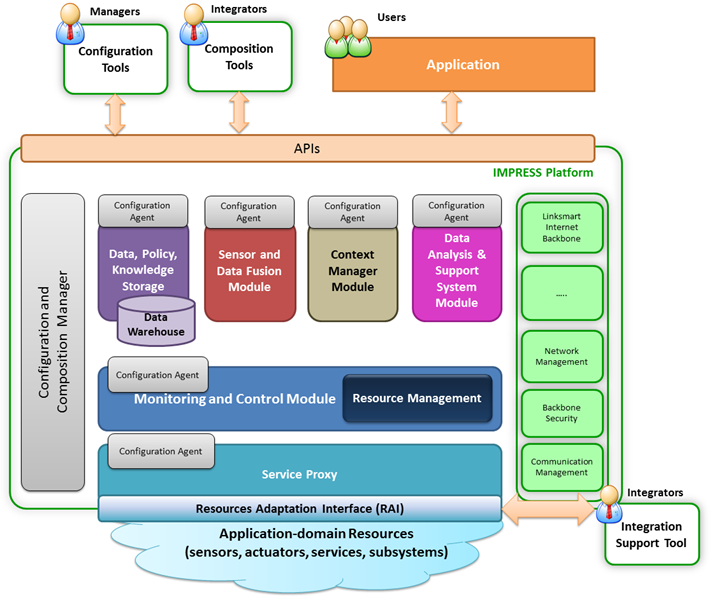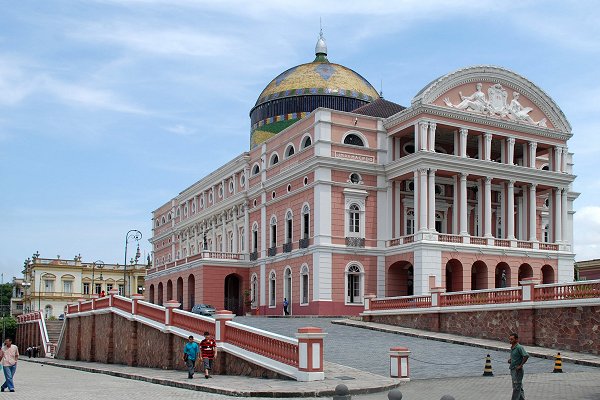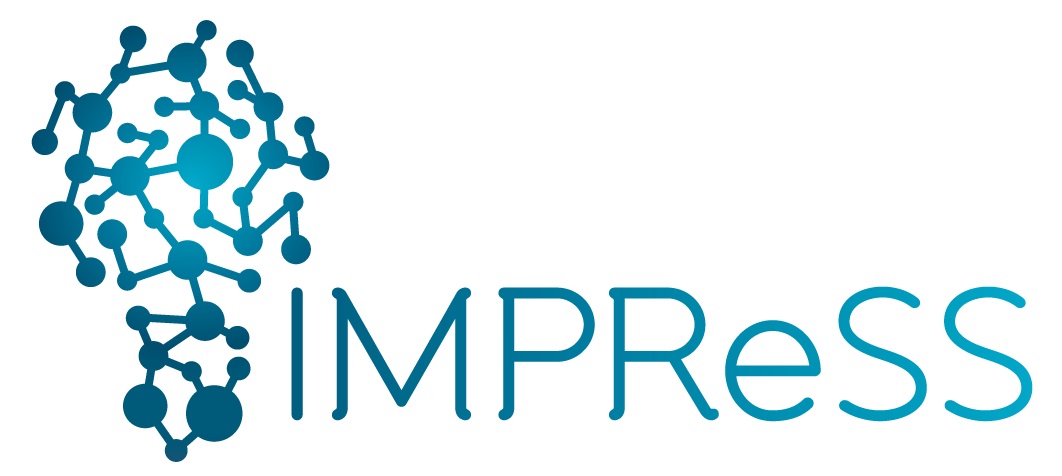 |
Issue #1 - published by the IMPReSS project - October, 2014 |
 |
 |
 |
 |
 |
Welcome to the IMPReSS project |
 |
 |

On behalf of the IMPReSS project consortium I would like to welcome you to the first issue of the IMPReSS newsletter. The IMPReSS project is EU-Brazil cooperative research project funded by the European Commission and the Conselho Nacional de Desenvolvimento Científico e Technoogico. The project kicked off in September 2013 and will run until February 2016.
The IMPReSS project is developing a Systems Development Platform (SDP) which will be usable for any system intended to embrace a smarter society. IMPReSS will enable developers to design, model and operate systems composed of a large number of independent, heterogeneous and interacting (sub)systems as well as to monitor and control their potential emergent behaviour in systems-of-systems engineering perspective. The tools and components of the IMPReSS SDP are applicable to a range of Smart Society applications but in the IMPReSS project we will focus on smart energy management. In addition, we will demonstrate the potential of IMPReSS to increase public awareness of energy consumption and promoting energy efficient behaviour by deploying IMPReSS enabled applications in two public buildings in Brazil: The world famous Teatro Amazonas Opera House in Manaus and at the renowned University of Pernambuco in Recife.
I am also pleased to announce that the IMPReSS project has already had four scientific papers published on the topics of semantic device discovery, mixed criticality resource management, semantic interoperability architecture and an Internet of Things Prototyping Toolkit. Please visit our project website for further information and download links to these papers.
In this first issue of the project newsletter, we initially present an overview of the key innovative technologies that will be developed in IMPReSS. Next, we describe how and why user requirements drive the technological development work in the IMPReSS project and, in line with this, the vision scenario for the Teatro Amazonas pilot is presented. The development work in the project is already well under way and we explain here in brief the development of a key IMPReSS SDP feature: The Context Manager Module.
The second newsletter is planned for February 2015 which among other topics will feature a presentation of the first year prototype. Until then, I would like to encourage readers to stay tuned to the project’s progress via the website at www.impress.in-jet.eu
Enjoying the reading!
Dr. Markus Eisenhauer, Project Coordinator, Fraunhofer FIT
to
the top  |  |
 |
 |
 |
| | IMPReSS – an innovative approach to system development |
|
 |
IMPReSS project will provide a more holistic approach to system development thereby solving the complexity of system development.
The key innovative technologies that will be developed by IMPReSS are related to:
Integrated Development Environment based on Model Driven Development
Model Driven Development increases the automation level in software development and makes intensive use of reusable models to visualize the code, or the problem domain. Since its primary goal is to raise the level of abstraction at which developers work, the amount of developer effort is expected to be reduced. For example, developers will be able to easily integrate different elements such as sensors and actuators and with fine-grained data analysis. The IMPReSS Integrated Development Environment will feature:
 • Domain specific languages • Domain specific languages
 • Commissioning tools • Commissioning tools
 • Physical world virtualisation. • Physical world virtualisation.
Service-Oriented Middleware & Mixed Criticality Systems
The IMPReSS project will leverage on the existing middleware solution, LinkSmart, developed in Hydra project and being extended in other EU projects. LinkSmart will be tailored in IMPReSS to allow running it on cost-efficient hardware, such as the ARM architecture, which supports available platform modules and application-domain resources. The IMPReSS project will result in extensions and improvements to the existing LinkSmart middleware, such as adding a resource management module that is responsible to schedule the access to services and devices based on the criticality of the applications. In addition, IMPReSS will allow for connecting several real-time and mixed criticality systems, along with non-real time systems such as WSNs, to form larger complex systems that are programmable by unified, simple APIs.
Network and Communication Management for Internet of Things
The IMPReSS project will produce a Network Management Tool that will act as a single interface for network management and aims to ensure interoperability between different network management models. Furthermore, IMPReSS will extend Network Management to work on constrained hardware implementing a more lightweight communication protocol than the existing Link Smart protocols. This work will involve investigating current security architectures for WSNs in particular and utilize them to specify and test dynamically configurable security architecture for the mixed criticality systems envisioned by IMPReSS.
Cloud-based Data and Context Management
The IMPReSS platform will not only deal with large amounts of data provided by different sensors and obtained from different sources, it will also provide data mining tools to developers and use data mining to generate rules to decision support. The IMPReSS project will also focus user context management by providing data analysis modules and occupancy models that can be used by developers to analyse and predict occupancy in a building. This will increase the efficiency of energy policies in buildings.
These are just some of the key innovations that will be realised by the IMPReSS project. Stay tuned via the project website and future newsletters as the project progresses to learn more about how IMPReSS will drive innovative technologies supporting Smart Society.
to
the top  |  |
 |
 |
 |
| |
User Requirements Drive the Development Work |
|
 |
Smart energy management is a key feature of Smart Cities and this application domain has been chosen as a good showcase for demonstrating and validating IMPReSS.
IMPReSS enabled applications will be deployed at the two IMPReSS pilots, Teatro Amazonas and University of Pernambuco, in order to demonstrate the potential of a smart system for reducing energy usage and CO2 footprint in existing public buildings.
The IMPReSS project has adopted an iterative approach and participatory design for developing the technological parts of the SDP platform which is initiated from the requirement engineering process. The needs and requirements of the two IMPReSS pilots, Teatro Amazonas and University of Pernambuco, are thus the engines that drive the development work. The pilots’ user requirements will feed directly into the design specification of the IMPReSS architecture and technical components.
One of the first tasks in the project was to define scenarios that properly described the project’s visions for IMPReSS enabled smart energy management applications. The scenarios were defined according to these four principles: They must have a) cross sectoral applicability, b) address heterogeneity of the Internet of Things and their networks, c) require management of large amounts of data, and d) human centric applications. The next article in the newsletter describes the scenario for Teatro Amazonas.
Based on the scenarios, we defined several use cases that will be implemented in the real world, i.e. at the IMPReSS pilot sites. Use cases were defined from two perspectives: from the end-user perspective (i.e. the IMPReSS pilot) and from the developer user perspective (i.e. the IMPReSS SDP developer). The next step was to elicit user requirements and translate these into technical specifications for the IMPReSS SDP.
The work with requirements is an important task as its results will feed into the development work carried out in the different work packages in the project. The figure below gives an overview of work package structure defined for IMPReSS.

While this first task in the project has ended successfully – the completion of the first year prototype is well underway – the requirement engineering activity is by no means finished. As development work progresses and a first prototype is built, requirements will go through a quality check, lessons will be learnt and evaluation will be carried out. The results will often lead to a refinement of existing requirements and the creation of new requirements, thereby starting the requirement engineering process again for a second iteration as illustrated in the figure above. This approach is intended to ensure that the finished product, the IMPReSS SDP, meets the needs and requirements of the users. And that it fulfils the project’s objective, namely, to develop a System Development Platform that can be used to facilitate the rapid development of applications for managing mixed criticality applications.
to
the top  |
 |
 |
 |
 |
| |
Teatro Amazonas User Scenario |
|
 |
The IMPReSS platform will allow developers to integrate legacy systems, use the available building blocks, orchestrate them to create an intelligent energy management system that relies on natural resources (like daylight and solar energy) and control the operation of both passive and active environmental systems to ensure the best possible comfort conditions with the most efficient use of energy.
The intelligent energy monitoring and smart control of appliances at the Teatro Amazonas  will efficiently and effortlessly optimise the energy usage without compromising comfort or convenience. At the same time, the platform provides an enormous publicity potential, establishing the necessary public awareness to change the attitude towards energy usage and CO2 footprint, thus creating a wide public base for necessary changes in actual human behaviour to realise long-term energy savings. The demonstration will use its real-time energy-awareness services for all users of Teatro Amazonas
will efficiently and effortlessly optimise the energy usage without compromising comfort or convenience. At the same time, the platform provides an enormous publicity potential, establishing the necessary public awareness to change the attitude towards energy usage and CO2 footprint, thus creating a wide public base for necessary changes in actual human behaviour to realise long-term energy savings. The demonstration will use its real-time energy-awareness services for all users of Teatro Amazonas
Additionally, this showcase will create international awareness far beyond Teatro Amazonas, the City of Manaus and Amazonas State, and moreover become a tourist attraction in its own right, showing a successful integration of national historic heritage, green awareness and ecological sustainability.
Applications for energy management systems are the primary interest for the theatre. Any management system will be an improvement over the present status.
The management system must be able to measure, analyse and show (also in real time) energy consumption and the building managers must to be able to analyse the relation between energy consumption and occupancy in the different sectors of the theatre. Another need is for a management system that can reduce energy costs through intelligent comfort control and inclusion of cheaper, Renewable Energy Resources. Finally, the management system must be able to compensate for instabilities in power supply through short and long term forecasting and management of consumption.
to
the top  |
 |
 |
 |
 |
| |
Managing Energy Efficiency Context Information |
|
 |
The IMPReSS project’s aim is to develop a system for efficient energy management thereby promising to reduce energy usage by 10-20%. This will require the development of innovative components for the IMPReSS platform.
One such component is the Context Management Module which will keep and manage context information related to users and systems. If the system is able to understand and deal with context information, the behaviour of energy saving applications will be optimised. For example, consider the following scenario:
At the Federal University of Pernambuco in Recife, Brazil, the Differential and Integral Calculus I course in the engineering program is obligatory for first year students. Although the classroom is large it is filled to the brim. As most days, the weather today is hot and humid and this combined with a packed room increases the temperature inside the classroom considerably. Luckily, the university has recently installed an IMPReSS-enabled application for energy efficiency management and all classrooms are now equipped with thermometers and presence sensors. The application detects the large number of people and the high temperature and immediately controls the air conditioning system to operate in full capacity.

As this scenario illustrates, a context-aware system is able to collect and reason the context information and adapt the corresponding applications accordingly without explicit user intervention. In IMPReSS this will be achieved through the Context Manager Module which extracts data from available Application-domain Resources, e.g. sensors, actuators, services, subsystems etc., in other words, basically all the entities that the IMPReSS platform can interoperate with.
The first stage when developing the Context Manager Module has focused on gaining a better understanding of the features needed by a context manager module. This has included a study and evaluation of the typical patterns for energy efficiency context management. As a result from this work, templates for five Smart Entities – subject, resource, place, fusion, and rule - have been identified which will make it easier to understand, model and program the context-awareness features of the IMPReSS SDP.
to
the top  |
 |
 |
|
 |
 |
|
 |
|





 will efficiently and effortlessly optimise the energy usage without compromising comfort or convenience. At the same time, the platform provides an enormous publicity potential, establishing the necessary public awareness to change the attitude towards energy usage and CO2 footprint, thus creating a wide public base for necessary changes in actual human behaviour to realise long-term energy savings. The demonstration will use its real-time energy-awareness services for all users of Teatro Amazonas
will efficiently and effortlessly optimise the energy usage without compromising comfort or convenience. At the same time, the platform provides an enormous publicity potential, establishing the necessary public awareness to change the attitude towards energy usage and CO2 footprint, thus creating a wide public base for necessary changes in actual human behaviour to realise long-term energy savings. The demonstration will use its real-time energy-awareness services for all users of Teatro Amazonas


